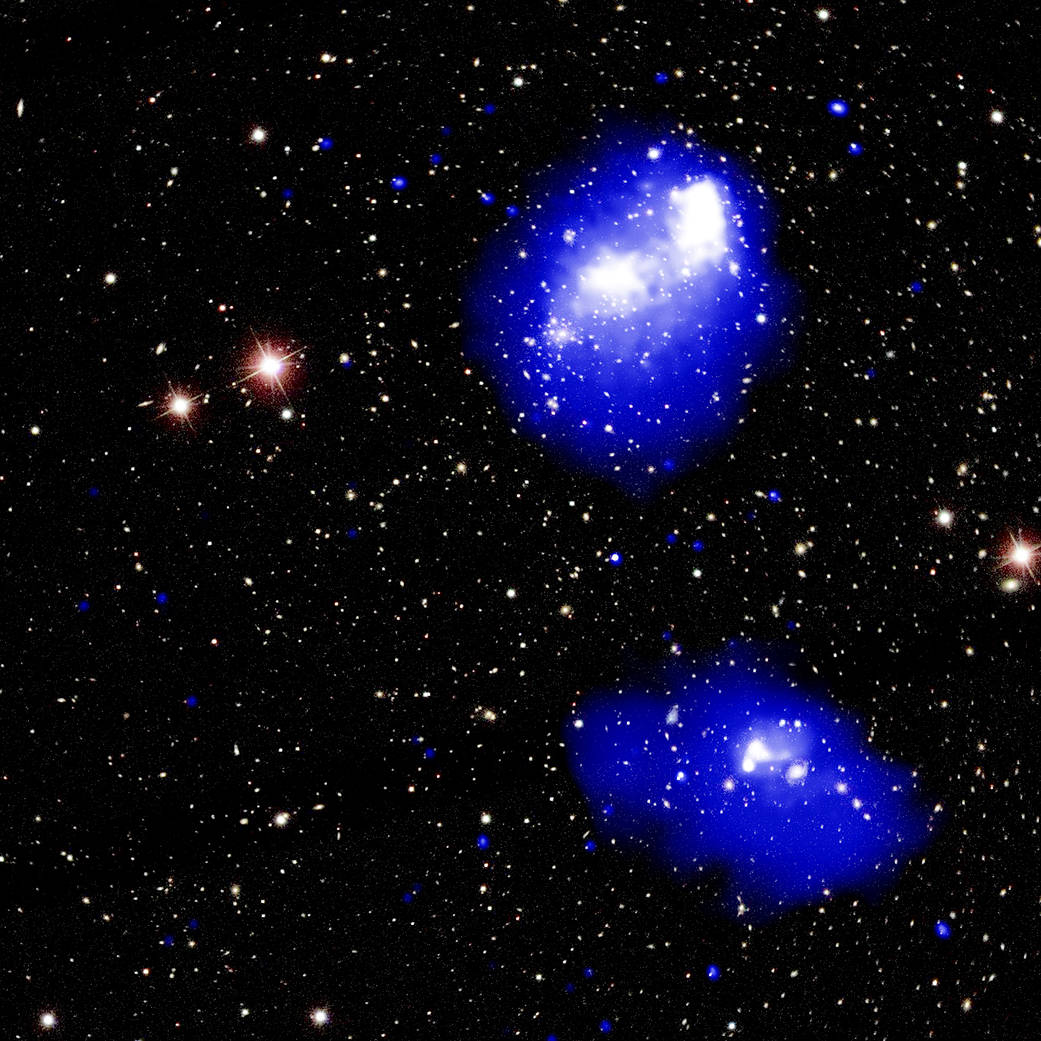一个正在形成的巨大星系群
Astronomers using data from the Chandra X-ray Observatory and other telescopes have put together a detailed map of a rare collision between four galaxy clusters. Eventually, all four clusters – each with a mass of at least several hundred trillion times that of the Sun – will merge to form one of the most massive objects in the universe.
Galaxy clusters are the largest structures in the cosmos that are held together by gravity. Clusters consist of hundreds or even thousands of galaxies embedded in hot gas, and contain an even larger amount of invisible dark matter. Sometimes two galaxy clusters collide, as in the case of the Bullet Cluster, and occasionally more than two will collide at the same time.
The new observations show a mega-structure being assembled in a system called Abell 1758, located about 3 billion light-years from Earth. It contains two pairs of colliding galaxy clusters that are heading toward one another. Scientists first recognized Abell 1758 as a quadruple galaxy cluster system in 2004 using data from Chandra and XMM-Newton, a satellite operated by the European Space Agency (ESA).
X-rays from Chandra are shown as blue and white, depicting fainter and brighter diffuse emission, respectively. This new composite image also includes an optical image from the Sloan Digital Sky Survey. The Chandra data revealed for the first time a shock wave — similar to the sonic boom from a supersonic aircraft — in hot gas visible with Chandra in the northern pair’s collision. From this shock wave, researchers estimate two clusters are moving about 2 million to 3 million miles per hour (3 million to 5 million kilometers per hour), relative to each other.
The team also used radio data from the Giant Metrewave Radio Telescope (GMRT), and X-ray data from the European Space Agency’s XMM-Newton mission.
Image Credit: X-ray: NASA/CXC/SAO/G.Schellenberger et al.; Optical:SDSS
天文学家利用钱德拉X射线天文台和其他望远镜获得的数据,绘制了一幅详细的星系团碰撞图。最终,这四个星团——每一个的质量都至少是太阳的数百万亿倍——将合并成宇宙中最大的天体之一。
星系团是宇宙中由引力维系在一起的最大结构。星系团由数百个甚至数千个嵌入高温气体中的星系组成,并且包含了更大量的看不见的暗物质。有时两个星系团会发生碰撞,就像子弹星系团一样,有时两个以上的星系团会同时发生碰撞。
新的观测结果显示,在距离地球约30亿光年的Abell 1758星系中,一个巨型结构正在形成。它包含了两对相互碰撞的星系团。2004年,科学家首次利用钱德拉(Chandra)和XMM-Newton(欧洲航天局(ESA)运营的一颗卫星)的数据,确认了Abell 1758是一个四重星系团系统。
来自钱德拉的X射线显示为蓝色和白色,分别显示较弱和较亮的漫射。这张新的合成图像还包括来自斯隆数字巡天的光学图像。钱德拉的数据首次揭示了一种激波——类似于超音速飞机的音爆——在与北方对碰撞的热气体中可见。从这个冲击波中,研究人员估计两个星团相互之间的移动速度大约是每小时200万到300万英里(每小时300万到500万公里)。
该团队还使用了来自巨型米波射电望远镜(GMRT)的无线电数据,以及来自欧洲航天局XMM-Newton任务的X射线数据。
图片来源: X-ray: NASA/CXC/SAO/G.Schellenberger et al.; Optical:SDSS

